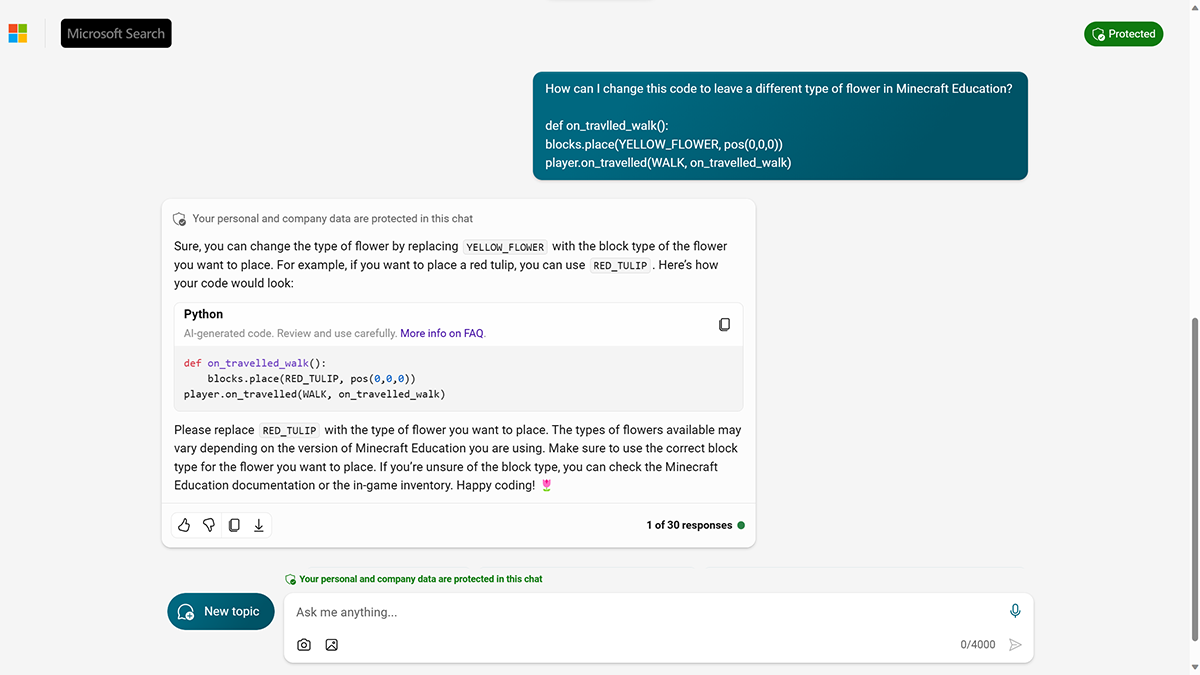Coding and AI
The integration of AI into education can support coding through computer science courses and beyond.
Coding and computational thinking with AI
Educators can implement new strategies to enhance the coding literacy of all learners by aligning AI-powered teaching practices with the four components of computational thinking—abstraction, decomposition, algorithmic thinking, and pattern recognition.
Abstraction: Simplify complexity with Minecraft Education
Abstraction is a key skill in coding, as it allows programmers to simplify complex problems and focus on the essential aspects. Minecraft Education is a great tool for learning abstraction as it lets learners create and explore virtual worlds using code. By using code blocks, learners can design and manipulate their own Minecraft environments by applying abstract concepts to concrete outcomes. Minecraft Education can be used in parallel with large language models (LLMs), like Copilot, to help learners generate and improve their code by setting out logic in step-by-step instructions. The hands-on learning experiences built into the game break down complex ideas for learners, making coding more accessible and less intimidating. Learners might use Copilot to generate customized, simplified directions on how to build their ideas in Minecraft Education.
Decomposition: Break down problems with Microsoft MakeCode
Decomposition is the process of breaking down a complex problem into smaller, more manageable parts. Microsoft MakeCode, a block-based coding environment, specializes in teaching this skill. Learners can tackle intricate coding challenges by constructing solutions piece by piece, using an intuitive drag-and-drop interface. This approach not only makes coding more digestible but also instills a structured problem-solving mindset that’s crucial in computer science. Learners who are ready to do more can advance to using JavaScript or Python coding languages in MakeCode. Because MakeCode is built into Minecraft Education, learners apply their knowledge to their build projects inside the game. Copilot can assist learners by analyzing Python or JavaScript code and making recommendations for optimization. It can also be helpful for educators to assess learner-produced code and provide suggestions or feedback.
Algorithmic thinking: Craft step-by-step solutions
Algorithmic thinking involves developing a step-by-step solution to a problem. AI-powered coding tools, like GitHub Copilot, offer interactive platforms where learners can experiment with creating algorithms. When learners receive immediate feedback on their code, they can refine their logical thinking and understand the consequences of each step in their algorithm. This iterative learning process encourages a deeper comprehension of how different coding elements interact to produce desired outcomes.
Pattern recognition: Identify trends and solutions
Recognizing patterns is key in coding as it allows for the identification of similarities and differences in data and behavior. Copilot can analyze vast datasets and help learners identify patterns that would be challenging to discern manually. Through built-in activities in Minecraft Education and project exercises in MakeCode, learners come to recognize and apply patterns, fostering critical skills for debugging and optimizing code.
Sample Copilot response for Minecraft Education coding question accessible (PDF)
One way to get learners started with coding and responsible AI is to use Minecraft Education’s Hour of Code: Generation AI. Learn more about Generation AI activities at aka.ms/HourofCode.
